I’ve had a few people tell me, after their trips to Walt Disney World, that they’ll never go back. “The lines were long; the kids were tired; the Jungle Cruise jokes were lame; the Rapunzel ride was actually just a bathroom,” they say. But, my (professional architect‘s) opinion is that those poor souls have missed the forest for the trees… they’ve missed the whole point of what Walt Disney World IS.
But to get to what WDW IS, I think we need to start at what it is NOT. Walt Disney World parks (and the other Disney Parks around the globe) are not just amusement parks. Walt Disney World has a “secret sauce” that the Imagineers have used to make the parks different that any of their competitors. While some other amusement and theme parks do a little of what Disney does, no one does it quite like them. And so I argue that it is this “secret sauce” that makes the magic happen. And that secret sauce is the theming that the architecture provides.
Magic Kingdom, Epcot, Hollywood Studios, and Animal Kingdom are not just amusement parks. They’re not even just theme parks – which are typically more polished than amusement parks. Instead, I believe that they belong in their own category.
And we could start with a clear comparison: theme park vs amusement park. But, let’s first start with a couple of other types of parks. We need to go back further in time to find the beginnings of amusement parks in America.
Theme Park vs Amusement Park: Fairs and Carnivals
In what should maybe be considered the antithesis of Walt Disney World parks, fairs and carnivals are smaller, humbler, and temporary in nature. While the modern fair and the modern carnival are basically indistinguishable from each other, they have different histories here in the U.S. of A. Fairs in America date back to the mid-1800s, where farmers competed in produce, recipe, and livestock judging in big open fields. Rides and healthy snacks like deep-fried Twinkies came later to supplement the fun.
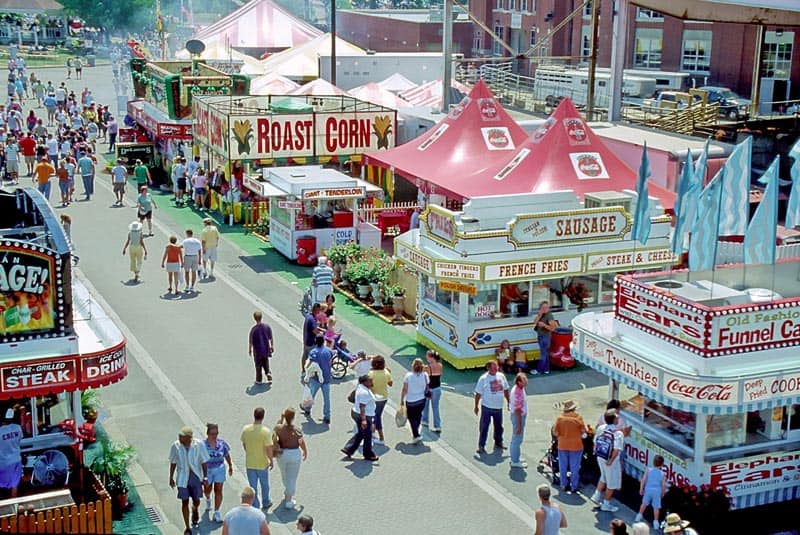
Carnivals here in the States also started in the 19th century. They often had circuses, music and dancing, and small amusement rides like carousels. Unlike historical state and county fairs though, carnivals were typically traveling shows, touring the region or the entire country. Modern carnivals may now have some of the rides that you also find in amusement parks or theme parks: bumper cars, Wave Swingers, Carousels, Ferris Wheels, Tilt-A-Whirls, and even small compact roller coasters. Apparently, they too serve deep-fried Twinkies (seen in the lower right in the photo above). However, these rides rarely have thematic elements, save for bright colors and lights.
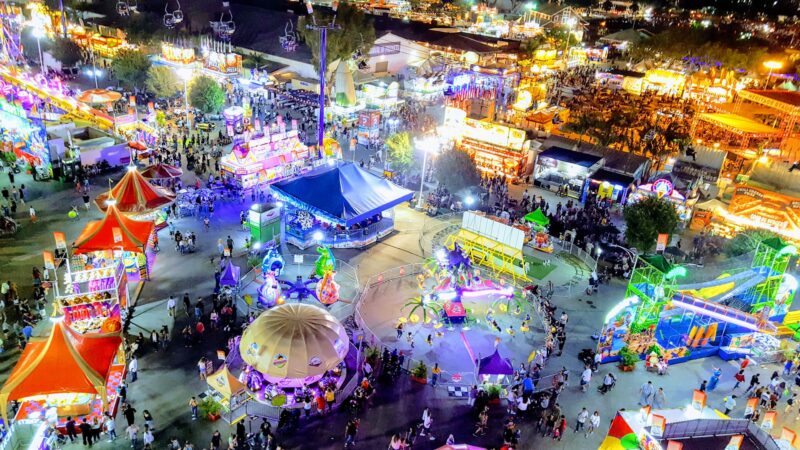
What do fairs and carnivals have in common as far as comparing them to Disney Parks? Due to their transient nature, they are very light on theming. Architecturally speaking, only tents, booths, and other temporary structures make up the “park”. These structures are usually crammed together on the fairground in order to maximize the number of attractions, with little to no focus on story or theme. Instead, it’s all about how much fun and deep-fried Twinkies one can consume. Theme? No. Pretty lights? Yes.
Theme Park vs Amusement Park: Amusement Parks
OK – let’s turn our attention to another category: amusement parks. As opposed to carnivals and fairs, amusement parks are more permanent. They often contain multiple lightly-themed “lands”. But it is very rare for an amusement park to try and truly immerse its visitors in those light themes.
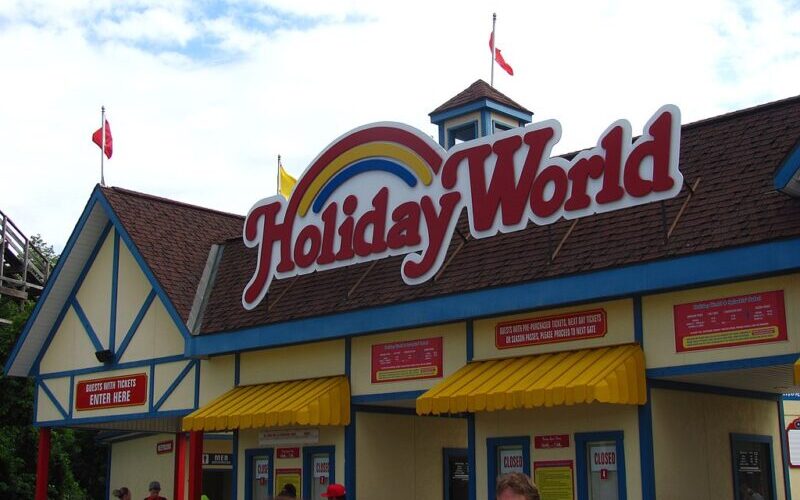
Most of them put a bit of focus on the architecture of the entrance area – trying to make a good first impression. But, beyond the entry “land” there’s not much focus on aesthetics. Some try a bit more than others. And Holiday World (shown above) actually straddles the line with theme parks, in my opinion. But, amusement parks are really not in the business of storytelling and immersive theming.
Instead, they are largely in the thrills business. Which is more than fine. Who doesn’t like a good thrill? The “Coaster Wars” are fought amongst amusement parks, with parks vying for accolades. If you’ve ridden the tallest or fastest of a certain type of roller coaster, you were likely at an amusement park. And living in the Washington, DC area, I have several amusement parks within a 2-3 hours drive: Six Flags America, Kings Dominion, Hersheypark, and 2 or 3 others. Riding roller coasters all day until you can’t stand straight has a place, and millions of annual visitors to these parks agree.
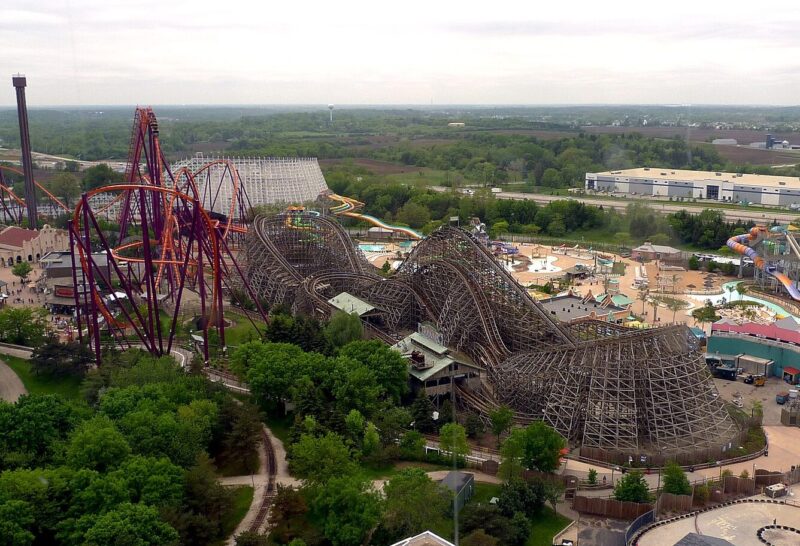
But, amusement parks – especially the coaster-centric parks – pay little attention to sightlines and whether a coaster or ride in one land is visible from another land with a different theme. You can see an example of that in the image above from Six Flags Great America. Instead, coasters are often right on top of one another, and the “theming” is boiled down to a ride name and a cool logo.
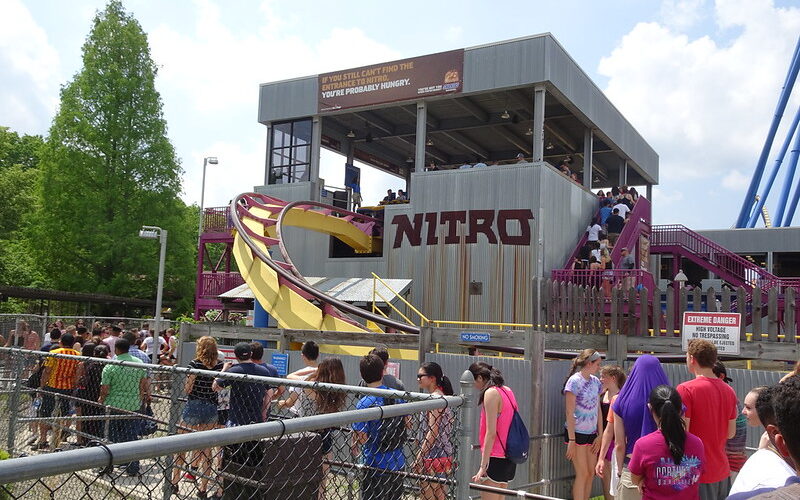
The picture above is of the station of a 200+ foot tall hypercoaster at Six Flags Great Adventure. The ride name looks like it’s spray-painted on to the side of a corrugated metal box. Theme!
Other examples of amusement parks are:
- Six Flags parks – Six Flags Fiesta Texas starts sniffing at Theme Park territory
- Cedar Fair parks – Cedar Point (roller coaster mecca), Kings Dominion, Kings Island, Carowinds, Knott’s Berry Farm, etc.
- Hersheypark
- Kennywood
- Coney Island
- Lake Compounce – operating since 1846
- Knoebels
- and many many others…
But, I think it’s obvious that while amusement parks are great fun, Disney Parks are not just amusement parks. They are something much more.
Theme Park vs Amusement Park: Theme Parks
Now we’re getting warmer! There is, admittedly, a blurry line between amusement parks and theme parks. It may be more accurate to think of the amusement park / theme park divide as a spectrum rather than a clear delineation. Some of the amusement parks listed above, for instance, have certain areas of the park (often the older areas) that start to put effort towards a “theme” or story. But, even these areas – Kings Dominion’s International Street and Six Flags Fiesta Texas’ Los Festivales, for example – have much simpler design details.
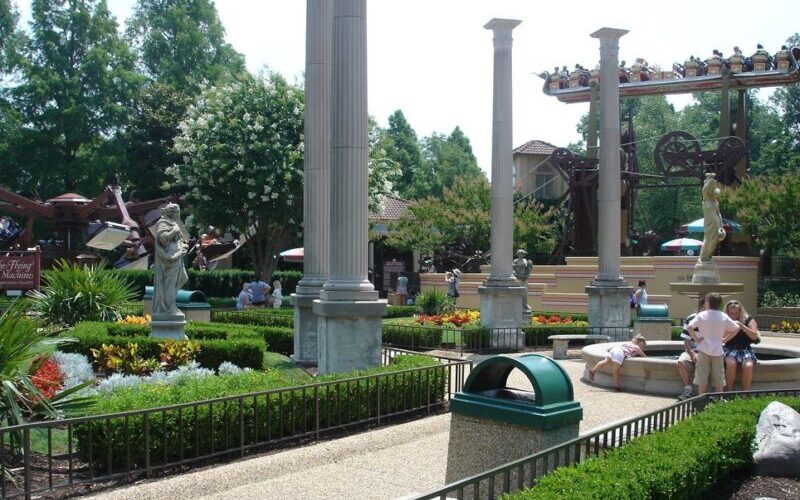
When we get into true theme park territory, we find that these parks have upped their theme game:
- the landscape is usually richer/lusher
- the rides take on – and amplify – the theme of the lands that they’re in
- the level of the detail of the architecture is greater
- the ride loading stations and queues (park-industry word for “lines”) are more “designed” than simple shelters and switchbacks
- other entertainment, such as shows, play a more prominent role
Some examples of theme parks include:
- Holiday World – small, family-owned; right on the edge of the amusement park/theme park line
- Silver Dollar City – Branson, MO 1880s-themed park
- Dollywood – Smoky Mountain-themed park with concerts and traditional crafts supplementing the great rides
- Legoland parks – very consistent theme
- Sea World parks – animal experiences alongside big thrill rides
- Busch Gardens – amazingly landscaped and well-themed parks; architecture detail is a step-below Universal and Disney.
Theme parks have thrill rides too by the way. Some of the very best roller coasters on the planet reside at Busch Gardens Williamsburg, Busch Gardens Tampa, Holiday World, Dollywood, and Silver Dollar City. But, because they’re in theme parks, the ride station buildings, and the theme of the rides themselves, tie strongly into the theme of the lands in which they’re located.
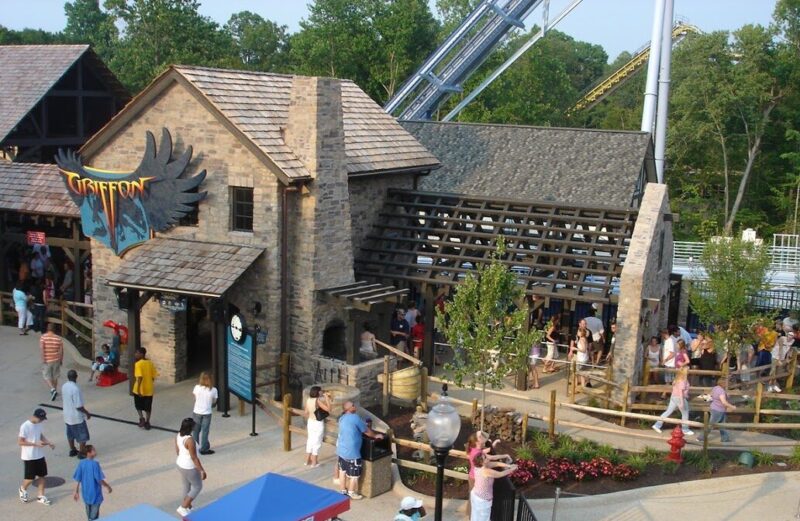
As I’ve mentioned a time or six, Disney Parks aren’t just amusement parks or theme parks. So where do the above theme parks fall short of the Disney Park standard? We’ll get into this more in a minute, but, in summary, I think it comes down to the level of detail in the architecture. There is a simplification of the smaller details of the buildings in theme parks. You may even be able to tell in the picture above that while the queue building for Griffon at Busch Gardens Williamsburg is beautiful and themed quite well, if you could zoom in you would notice that there are some “real-world” details missing.
Why Haven’t you mentioned Universal Orlando Resort?
Universal Parks – especially the two theme parks in Florida – kind of sit in their own mini-category. They are ALMOST at Disney’s level, but my impression having visited a few times, is that there are large areas of the parks where they just sort of mail it in. There are portions of Universal Orlando parks that definitely transcend the run-of-the-mill theme park category. The Wizarding World of Harry Potter lands are absolutely incredible, and are completely immersive. Port of Entry at Islands of Adventure, even though it’s an arrival “land”, is amazingly detailed and themed.
But, for me there are too many lands at Universal where the theming just doesn’t live up to what the best Disney Parks achieve:
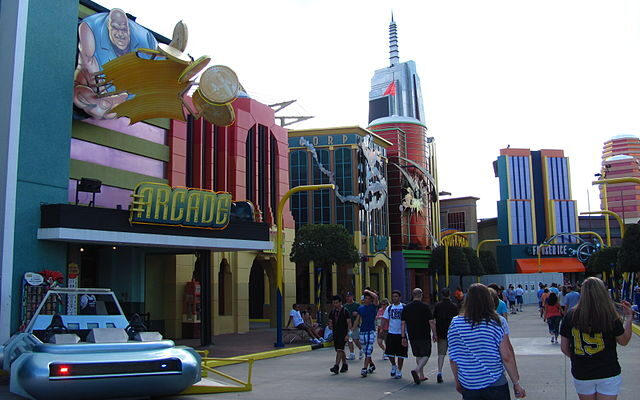
Take the picture above. I mean… friends… this is Six Flags level stuff in my opinion. None of the buildings use a forced-perspective trick believably. They all look squat and strangely toy-like. The 2-D super-hero billboard guys are really tacky. This is the antithesis of what The Wizarding World of Harry Potter is. People forgive this land because of its two world-class rides (The Incredible Hulk Coaster and The Amazing Adventures of Spider-Man). But the theming is just not well-executed.
And there are portions of Universal Studios Florida (the park next-door) that are almost complete devoid of theme. The original concept of the park was that you were at an actual movie studio. So, there are HUGE theme-less buildings that serve as mostly “backlot” that interrupt the otherwise immersive story of some of the other lands.
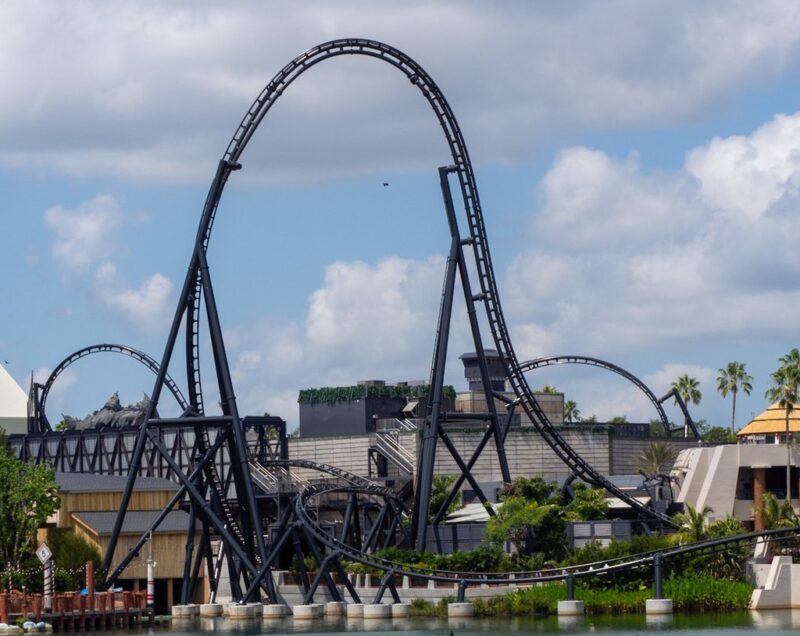
So, Universal comes close – and in a few places rivals Disney. They really bring the thrills (the Velocicoaster above has been considered to be one of the best roller coasters in the world). But, the Universal Parks don’t quite get into Disney Parks’ class… even though they are at the very top of the theme park list.
Theme Park vs Amusement Park: Disney Parks – Immersive Theme Parks
If I said earlier that the amusement park / theme park line was actually a spectrum, you may wonder why I’m suggesting a totally different category for Disney Parks. Why not just admit that Disney is at the high end of the spectrum? The truth is – there is just a HUGE gap between the best theme park and where Disney parks live. Yes, Disney Parks are not just amusement parks, but they also are not just theme parks. They really live in their own category, which I am calling Immersive Theme Parks.
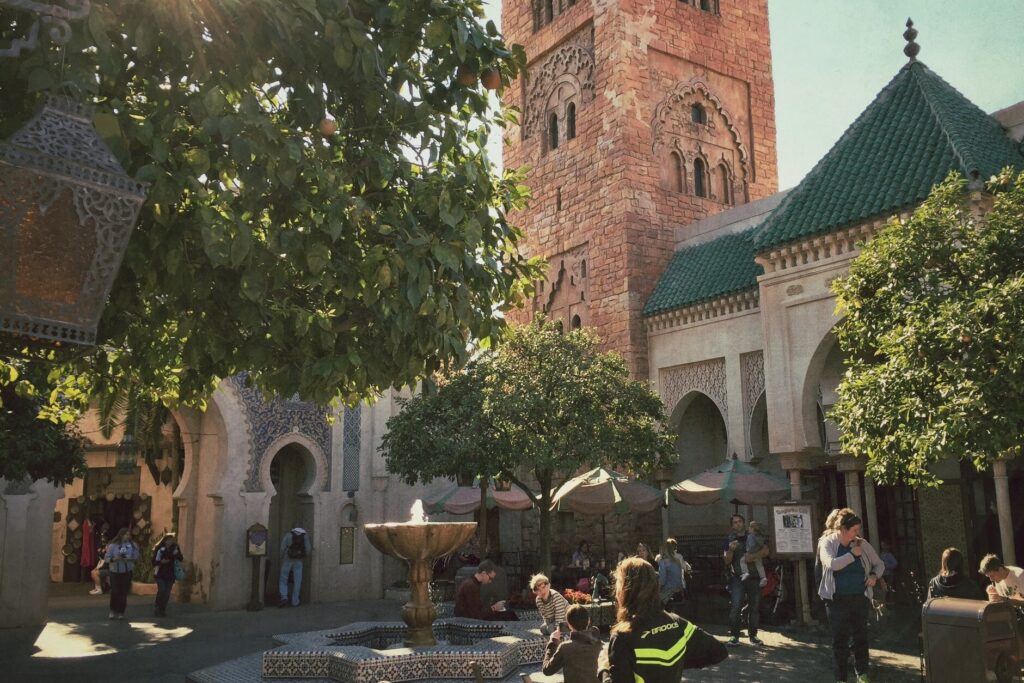
An immersive theme park allows you to suspend reality for a while and believe that you are someplace else – not a parallel universe per se, but certainly a fantasy of sorts. Disney Parks don’t just tell a story with their theming and architecture and landscaping, they immerse you in it. They convince you that you’ve been transported to that story or that place.
You actually hear people talk this way about Disney Parks, by the way, which shows that they are not just ordinary amusement parks. I have never heard someone say while at Six Flags, “Man, it’s almost just like I’m actually in Gotham City. Wow – for a moment I forgot that I was in ‘your state here‘.” (Yes – at The Wizarding World of Harry Potter at Universal people do actually say this.) But at Disney World, if you are willing to put your phone down for a minute (which Disney is making harder and harder to do), you can really feel like you’ve been transported to Pandora, Nepal, a small-town Main Street, or even the Star Wars universe.
Architecture Makes the Magic Happen
The real thesis of this blog is that the architecture and site planning of those lands is what allows you to feel truly transported into these places. I argue that this is what helps “make the magic happen”. More than the princess meet-and-greets, more than the quality of the rides, more than the fireworks, more than the churros. And yes, those things are really important too. But, if you take the design details of the architecture away – if you take the design of the layout of the land away – if you take the landscape design away, you are left with a mediocre amusement park that serves fried snacks. The architectural design makes Disney Parks… Disney Parks.
In fact, going back to those few poor souls I mentioned earlier, who come back from Disney World and say they hated it. I would wager that those people were not able to just look around and allow themselves to have their realities suspended. And look – for many people that’s a very hard ask. I’m sympathetic to the people who bring their little kids and are just trying to survive (I brought my 2-year old a few years back and stroller parking was the only thing I could focus on). And for years, Fastpass+ caused people to spend 1/3 of their time in the parks refreshing Fastpass availability for Slinky Dog Coaster, and another 1/3 of their time praying that someone else cancelled their Fastpass. I’m less sympathetic for people who visited during Christmas week and arrived at the parks at 10:30am and hated Disney World because of the crowds.
But, as I will detail in future trip planning blog posts, I think a good Disney World trip plan includes some exploring time… some sitting and watching time… some noticing the details time.
OK – back to why Disney Parks are in their own category… I think there are three things that differentiate Disney Parks from ordinary amusement parks and even theme parks:
The Level of Detail
First, Disney Parks go to a very intricate level of detail in their design of a ride or land or park. Actually, in episode 3 of The Imagineering Story on Disney+, Imagineer Coulter Winn describes four levels of detail that Walt Disney insisted upon. If you haven’t seen the series – go watch it now! We’ll go into greater detail in a future post, but briefly:
Level One – Detail from afar: In the countryside, you see the tops of buildings over the trees.
Think of the silhouettes of buildings and how a structure appears from afar (even from another land):
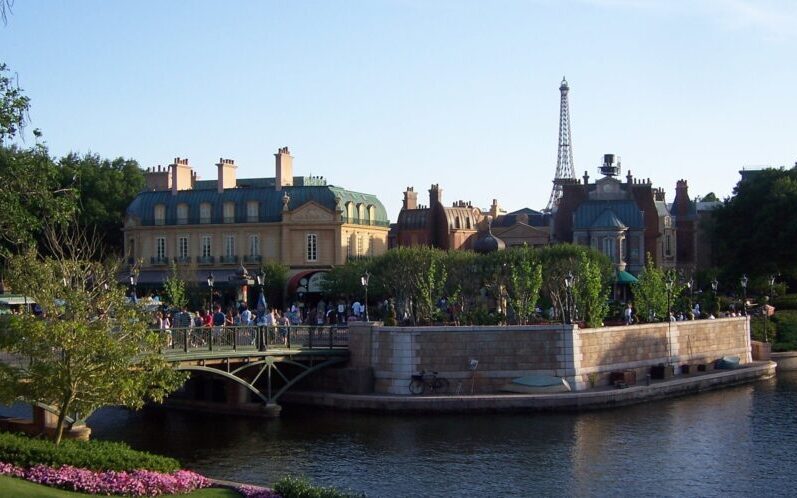
This image of France at Epcot, taken from just across the International Gateway, captures the gist. From a couple football fields away, you mainly notice the visual interest of the chimney tops breaking up what otherwise would be large continuous rooflines. The Eiffel Tower at this distance serves primarily as a landmark to entice people to cross the bridge and come to France.
Level Two – Placemaking: You’re on Main Street and notice the benches and the trees.
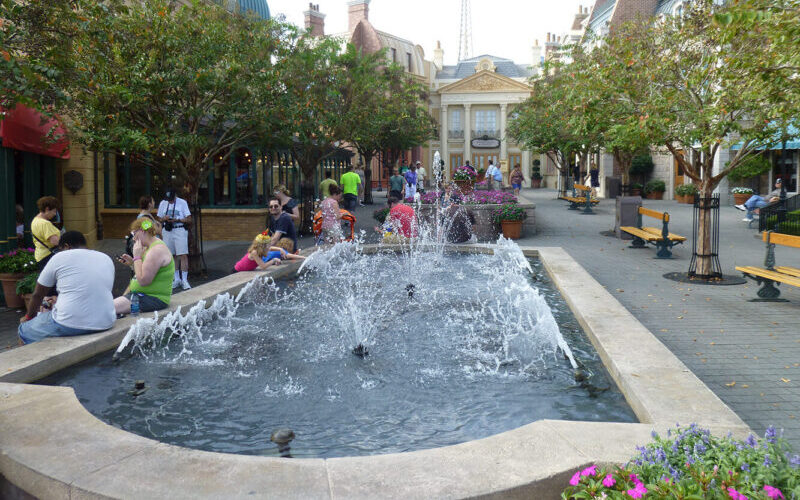
Using our Epcot example, once you cross the bridge and arrive at the France pavilion, you notice the detail in the pavement. The ornamental trees sit inside urban tree pit grates; designers have detailed the fountain and floral planters so as to double as bench seating. This Level 2 detail – the placemaking detail – really helps sell the idea that you are not in Kansas Florida anymore.
Honestly, you rarely see this kind of site detail in other parks – even in the best theme parks. In the image above, even the tree guards have been designed. That’s the kind of thing that really sets Disney Parks apart from other amusement parks.
Level Three – General detail of buildings: You notice the color, materiality, texture, and style of the buildings.
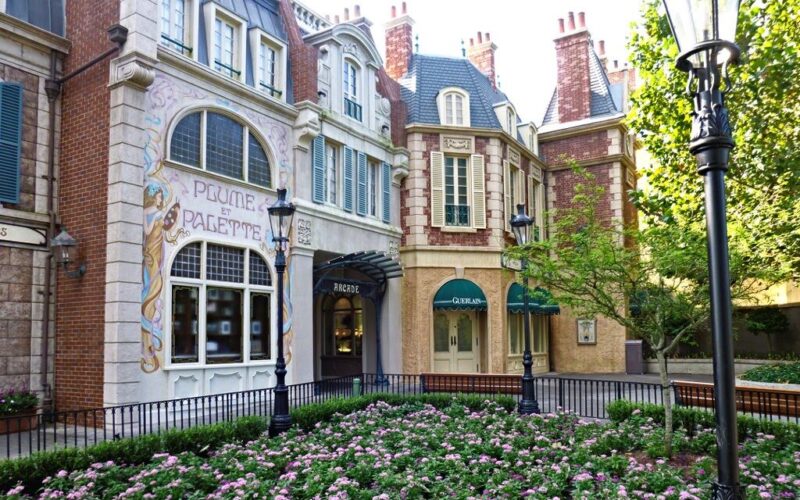
We’ve taken a right turn in France to take the picture above, which will now be a prominent view as we make our way to the Ratatouille ride. At this level of detail, the story of the buildings themselves begin to be crafted. What era and style were they built in? How do the color palettes play off neighboring buildings? Why do the buildings have that specific ornamentation? Note details like the scupper boxes and downspout design, the muntin pattern in the windows of Plume et Palette, the right-sized shutters.
These details convince you that you are in a different real-world than the one you left at the entrance to the park. Other theme parks attempt this level of detail at times. But, they almost never approach this kind of execution.
Level Four – Fine detail: You feel the texture and temperature of a doorknob.
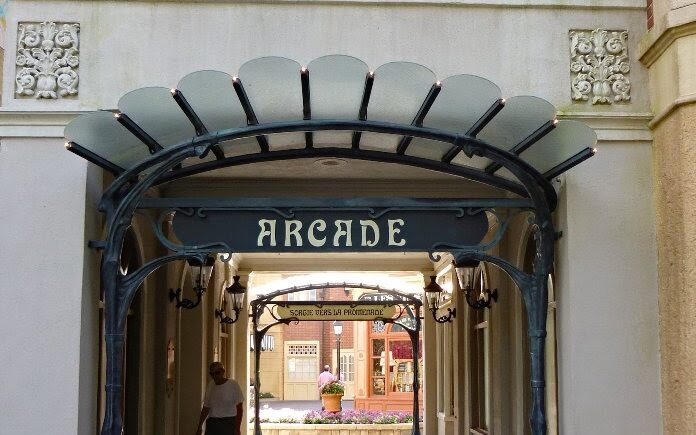
I apparently need to take more pictures of doorknobs. Maybe on my next trip. For now, I’ll focus on this Art Nouveau steel and glass canopy / awning seen on one of the buildings in the previous image. The point here is that Disney focuses on the zoomed-in details as well, whereas almost every other park – even the best theme park – USUALLY stops short of this, save for some areas of Universal Parks, and some one-off example at other theme parks.
The ironwork looks wrought by an artisan. You can begin to see and understand how the pieces of the canopy have been put together. And in many instances, these fine details – even things like the weathering of the materials – help deliver the story and complete the illusion that you are in a different world entirely.
Relentless Theme
Secondly – and briefly – Disney Parks are different from amusement parks and run-of-the-mill theme parks because they are relentless with the theming just described.
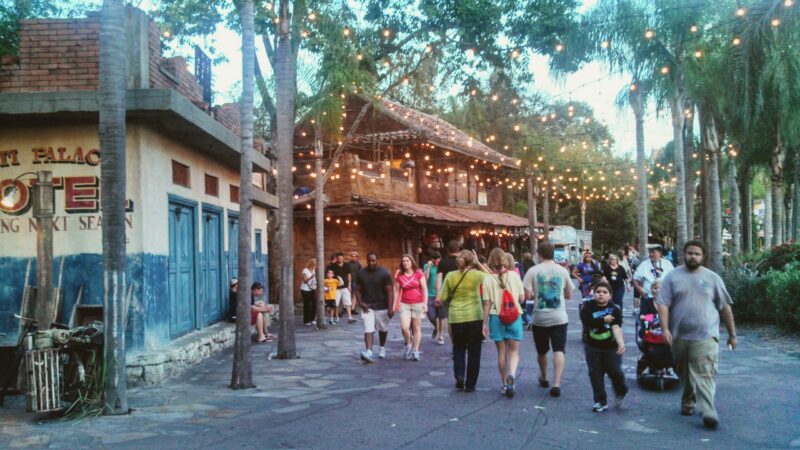
In the image above, the two intricately-themed buildings on the left are… bathrooms. That’s right… Walt Disney World parks consider even bathrooms, storage buildings, and back-of-house gates and structures to be “on stage”. So, even those types of buildings are designed to be part of the “show”.
Is every nook and cranny of Disney World relentlessly themed? Well… no. There are certainly areas where the Imagineers didn’t nail it. In fact, recently, some large show buildings housing rides have been left very exposed and visible from other lands with only “Go Away Green” or “Blending Blue” paint applied to make them disappear. But, by my estimation, Disney is batting .980 or so in this area, where it’s nearest rival – Universal – is batting .700. No one else is even in their neighborhood when it comes to the consistency of theming.
Story / Narrative
Aaaahh… story. This is the 3rd thing that Disney does that differentiates their parks from other theme parks. Just google “story+Blizzard+Beach”; “narrative+Big+Thunder+Mountain+Railroad”; “theme+Port+Orleans+resort”. I am not aware of any other amusement or theme park that creates backstories to their rides, lands, and resorts to the extent Disney does. It’s one thing to name a ride, paint it to evoke the name somehow, and put some props in the queue. But Imagineers at Disney actually create backstories that help them design the details of the land, all the way to Level 4. This will get covered in some future posts, but this design process leads to things like the total immersion you experience in Galaxy’s Edge and Pandora, and even Africa and Asia in Animal Kingdom:
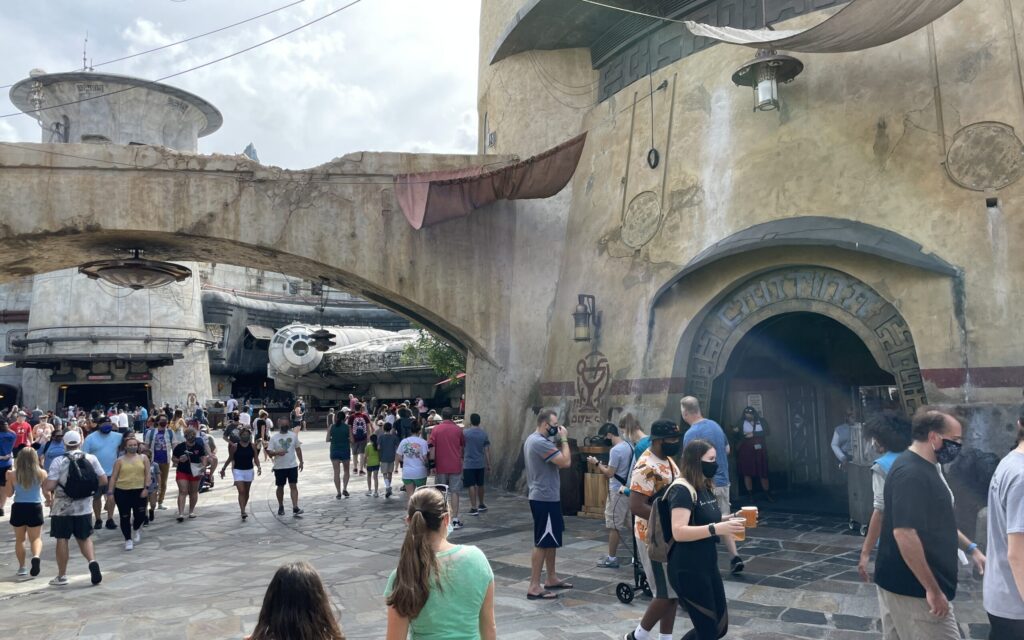
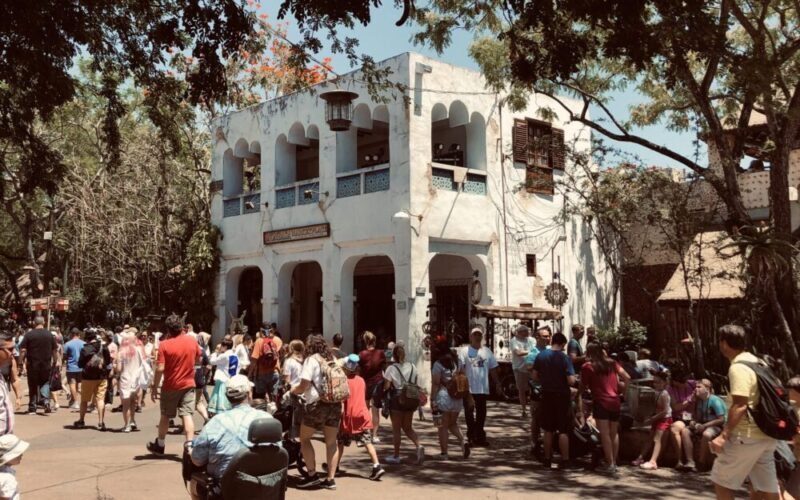
Whether they’ve published them or not, Imagineers have created backstories for all of the lands in Disney Parks. That created narrative helps inform the details at all of the levels in Point One above. This is a key differentiator between Disney Parks and their competitors.
A High Bar
Disney Parks set a pretty high bar. And the truth is, at times, they haven’t lived up to their own bar… The original Disney California Adventure at Disneyland Resort was very underwhelming. The land of arrival – Sunshine Plaza – didn’t seem to follow these rules much at all. Shops and rides were adorned with 2-D billboard graphics. Many of the rides were off-the-shelf, barely-themed, or not immersive. They have since remedied this with a massive makeover.
And Walt Disney Studios at Disneyland Paris Resort opened without much charm or story at all. It looked like an unfinished backlot of a movie studio. Thankfully, it too is in the midst of a makeover that will add Marvel, Star Wars, and Frozen lands and rides.
As I said before, the line between amusement parks and theme parks is a very blurry one. But, Disney goes above and beyond even the theme park category by implementing a multilevel approach to detail, a unrelenting, cohesive theme, and a story that immerses you. Disney Parks is peerless when it comes to this criteria.
But, I’d love to hear what you think!

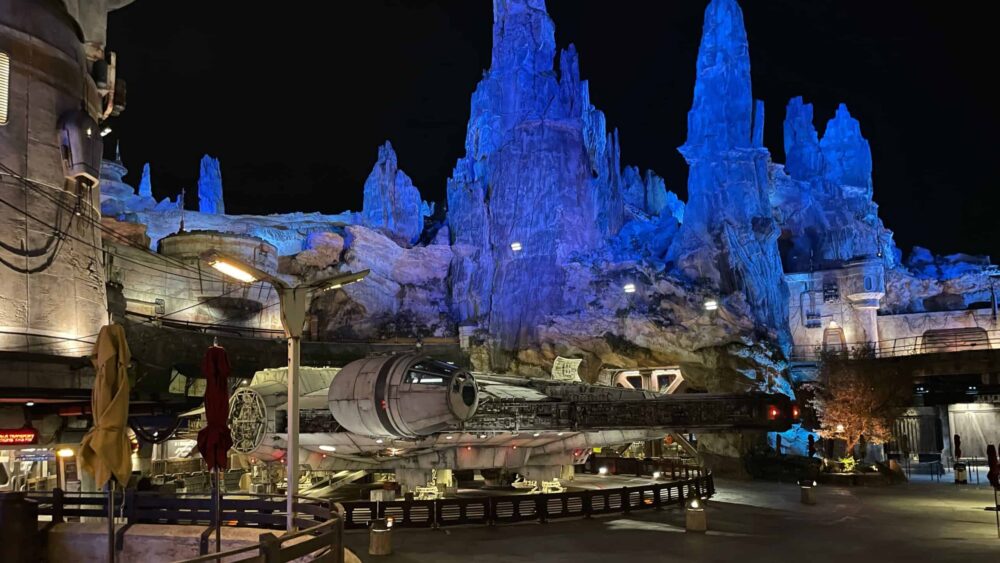
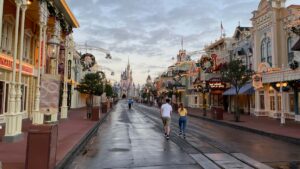
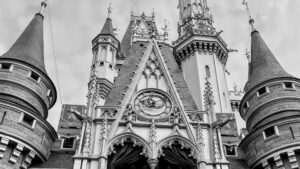
Love this article! Makes me want to get myself to a Disney park this coming year! Well done!
I’m looking forward to reading more, and will be checking out doorknobs on my next trip!
This is so interesting. I never thought about the different categories. I haven’t been to Disney in about 30 years. I can’t imagine the changes. Maybe it’s time to go back. Thanks for sharing.
Great and honest blog post!
I have to stop reading your blog! I want to go to Disney now more than ever!
No! Don’t stop reading! Thanks for the comment, Jenny!
This is one of the reasons that I love going to WDW! We have been to most of the parks that you mentioned (we are park junkies lol) and WDW and Harry Potter world at universal are definitely the top! The level of detail that you see in everything around you (for most places in the park) is amazing!
This is very good read!
I am a huge Disney fan, for all the reason you talk about–the architecture is amazing, the story telling, the feeling of being somewhere else…. this was my families go-to vacation for many years, my girls thought this was their second home!!
I’m a mahoosive Disney fan, I’m hoping to go to Euro Disney next year! (Not quite the same scale I know lol). I’ve always said Disney parks aren’t an amusement park, they’re a feeling!
thank you for disecting that information so informative. Its good to know the differences, also lines will always be long, we cant avoid that.
I love Disney! I hope to go back one day. Your post will let me see it in a new light. Thanks for sharing.